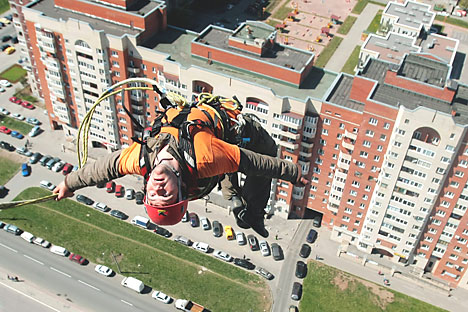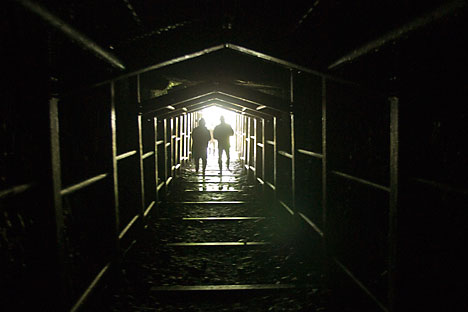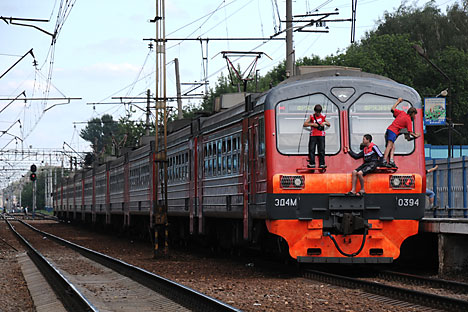Russian daredevils climb high and dig deep in search of adrenaline rush

Roofers
Source: On the roofs / Youtube
A now-famous YouTube video of two Russians – Vadim Makhorov and Vitaly Raskalov – climbing the 650-meter-tall Shanghai Tower shows the young ‘roofers’ reaching the top of the tower with ease - with almost no protection and minimal climbing equipment, and without meeting any builders or security guards along the way – and photographing themselves.
In reality, it wasn’t that easy. In an interview following their stunt, the two men said they had to choose the right time to get to the top of the tower. On the day Shanghai locals were celebrating Chinese New Year, the two Russians made their way to the construction site at midnight, climbed 120 floors in almost two hours, and then waited 18 hours for the clouds to clear so they could photograph the panorama.
People like Makhorov and Raskalov are not especially popular among Russian roofers, because thanks to them, this not-quite-legal hobby has gained attention and security guards are starting to take more interest in young people trying to climb onto roofs.
To get onto the roof, roofers first have to explore – examine buildings that might offer a good view, check for closed lofts, and make sure it is safe to enter the building. “We exchange convenient addresses with each other, but only with people we trust,” says Pavel, a young roofer. “When a video surfaces with an interesting site, as a rule we can’t go there because security will be tightened, and security guards who previously got in trouble for not being vigilant enough could beat up the climber.”
He says the purpose of these stunts is to photograph great views and drink beer on the roof, as well as to experience the danger of potentially getting caught. “In those moments, you feel like the hero in a Hollywood action movie,” says Pavel.
Diggers

Source: GettyImages / Fotobank
The complete opposite of roofing is digging. Diggers are people who prefer not to climb onto roofs, but to go underground into basements, metro tunnels, or the maintenance facilities of Soviet military factories. Diggers often try to track police officers engaged in anti-terrorist security. Metro tunnels are usually the hottest spots of interest.
“I’ve been digging since I was 12,” says 25-year-old Semyon. “There are people older than me who do it, but there are also a whole lot of young people. There are a lot of myths surrounding digging; for example, that people are looking for some secret second metro or cold war bunkers. But Moscow generally has a whole lot of interesting facilities that as a rule were formerly used for the military and are often no longer in use.”
The young man cannot explain why he risks his life to sneak into metro tunnels and run along the metro rails searching for technical openings with wires or technical documentation. “I’m just drawn to it,” he says. “I want to find something interesting, like a person looking for treasure in an adventure novel.”
Semyon has been questioned by police a number of times because police vigilance has increased after recent terrorist attacks. Police pay particular attention to people whose curiosity drives them to explore underneath the city. However, this official attention does not appear to have put Semyon off: “We even managed a rubber dinghy ride on the underground Neglinka River, which passes under the center of Moscow,” he says.
Zatsepery

Source: Lori / LegionMedia
Perhaps the most dangerous extreme hobby in which Russian youngsters participate is known as zatseping. This means hitching a ride on all kinds of machinery, from passenger and freight trains to public transportation and even metro cars. Since the high-speed Sapsan train opened up between Moscow and St. Petersburg (it can travel at up to 155 miles per hour), illegal ‘passengers’ have had to be removed from it several times.
According to the transport police, over 600 zatsepery were killed on Russian railroads in 2013 and 424 lovers of the dangerous sport were detained by police. Every accident caused delays in train schedules. However, it is quite difficult to combat because there is only a 100-ruble ($2.50) fine for it.
Young people use social media to arrange where to meet and where to ride. They even buy special keys that let them get into passenger trains from the outside. They try not to attract the attention of railway workers, who may use physical force to remove them from the train.
“I started to ride on the roof or in between train cars when I missed my train one day. Then I started to ride there when the train cars were too full,” Roman said in an interview on the RT television channel. He admitted that this type of entertainment can be dangerous but said it is an easy way to travel.
Young people say they engage in this type of entertainment – and any other type of extreme activity – for the adrenaline rush.
Jumpers

Source: Vadim Zhernov / RIA Novosti
This activity – a form of makeshift bungee-jumping - entails jumping off abandoned buildings or buildings under construction using a rope. Jumpers choose a tall structure then communicate with other jumpers by text message or online to arrange a visit to the site, usually on weekends.
If the building is abandoned, there is usually no difficulty jumping from it, but if it is under construction, jumpers have to go there when there are no construction workers onsite. Jumpers can avoid danger if the organizing team has experienced people who can use the equipment properly and make sure the participants are protected.
Read more: Flyboard - a new passion of Russian thrill-seekers
All rights reserved by Rossiyskaya Gazeta.
Subscribe
to our newsletter!
Get the week's best stories straight to your inbox



